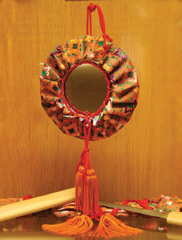An Illustrated Outline of Buddhism: The Essentials of Buddhist Spirituality (38 page)
Read An Illustrated Outline of Buddhism: The Essentials of Buddhist Spirituality Online
Authors: William Stoddart,Joseph A. Fitzgerald
Tags: #Philosophy

countries: Bön in Tibet, Confucianism and Taoism in China, and
Shinto in Japan.
Buddhism and Shintoism have both permeated Japanese civiliza-
tion, and anyone who takes an interest in Buddhism in Japan must
also know something about
Shintō
, “the way of the Gods”. That this is
so is strongly and clearly confirmed by tradition, as the two following
quotations show:
This is the land of the Gods [Shintoism]. The people should
revere them. In my essence, I am the Buddha Vairochana. Let
my people understand this and take refuge in the Law of the
Buddhas.
The Sun-Goddess Amaterasu
to the Emperor Shōmu in 742 A.D.
There is nothing but the difference between the trough and the
crest of a wave between what we call Gods [Shintoism] and
what we call Buddhas.
Hakuin
(1683-1768)
While the two religious traditions remain distinct, there have been
occasions where a Shintoist divinity could be assimilated to a Bodhi-
sattva, since the essence of each was identical.
We have taken the following schematic outline of Shinto mythol-
ogy from
Treasures of Buddhism
by Frithjof Schuon (section on Shinto,
pp. 183-199). Here and there analogies are made with elements from
Hindu metaphysics and cosmology which, as is so often the case, can
serve as useful points of reference.



130
An Illustrated Outline of Buddhism
Schematic Summary of Shinto Mythology and Cosmology
For an explanation of
the terms immediately
below, see pp. 48, 50-51.
Ame-no-Minakanushi-no-Kami
“BEYOND-BEING”
(“Divine Lord of the Center of the Heavens”)
(SUPRA-PERSONAL
Ame-no-Tokotachi-no-Misoko
GOD OR DIVINE
(“The Majestic One who stands on
ESSENCE)
the Floor of the Sky”)
Kuni-Tokotachi-no-Mikoto
“BEING”
(“Eternal Divine Earthly Being”,
(PERSONAL GOD)
“He who eternal y stands above the world”)
Tsuchi-Tokotachi-no-Misoko
(“The Majestic One who stands on the Floor of the Earth”)
Izanagi
(male)
Izanami
(female)
essence & substance
Takamimusubi-no-Kami
Kamumimusubi-no-Kami
(“Majestic Producer”)
(“Divine Producer”)
Amaterasu Ōmi-Kami
“EXISTENCE”
(Solar Goddess: “Great Divinity of the Shining Sky”) (
SAMSĀRA
)
Ohiru-Memuchi-no-Kami
(“She who possesses the Great Sun”)
Hiruko
(Solar God: “Great Sun”)
Jimmu Tennō
(founded Japanese Empire in 600 B.C.)






Shinto: Buddhism’s Partner in Japan
131
Alternative Schema
Ame-no-Minakanushi
(“Master of the Majestic Center of Heaven”)
Daigenshin
Kuni-Tokotachi-no-Mikoto
(“Great Divine Origin”) (“Eternal Divine Earthly Being”)
Takamimusubi
[
Izanagi
]
Kamumimusubi
[
Izanami
]
(“Majestic Producer”)
(“Divine Producer”)
Amaterasu
“The Three Noble Children of Izanagi”
In terms of Hindu cosmology:
Amaterasu Ōmi-Kami
sattva
(gentle and loving;
(upward or luminous
reigns over the high celestial spheres)
tendency)
Tsukuyomi-no-Mikoto
rajas
(Divinity of the Moon;
(expansive or igneous
reigns over the Kingdom of Night)
tendency)
Susano-wo-no-Mikoto
tamas
(Divinity of the Tempest;
(downward or obscure
reigns over the sea and earth)
tendency)
Yet Another Cosmogonic Schema
Izanagi
(“the male who invites”)
Izanami
(“the female who invites”)
Amaterasu Ōmi-Kami
Tsukuyomi-no-Mikoto
Susano-wo-no-Mikoto

